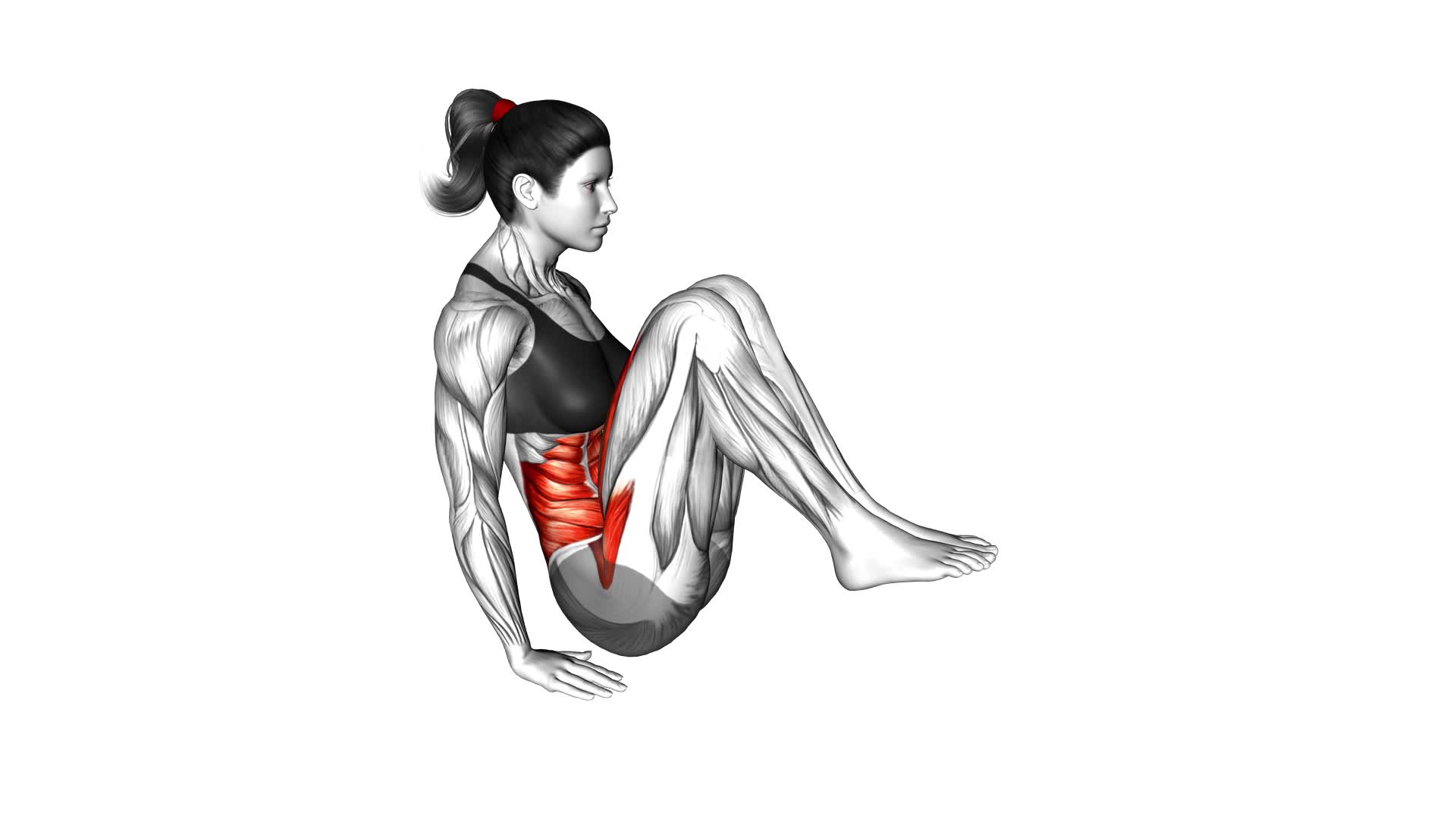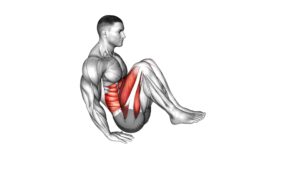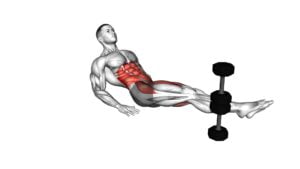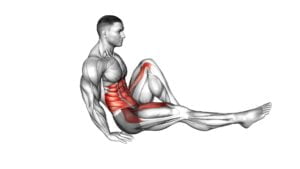Seated In Out Leg Raise on Floor (female) – Video Exercise Guide & Tips

Are you looking for a quick and effective exercise to target your leg muscles? Look no further than the seated in out leg raise.
Watch This Exercise Video
This simple yet challenging exercise can help strengthen and tone your legs, all while sitting on the floor. In this article, we will guide you through proper form and technique, common mistakes to avoid, and provide helpful tips for maximizing your results.
Watch our video guide and get ready to feel the burn!
Key Takeaways
- Seated In Out Leg Raise on the floor is a beneficial exercise for improving balance and strengthening hip muscles.
- Proper form and technique, such as keeping the back straight and engaging the core, are essential for maximizing the effectiveness of the exercise.
- Common mistakes to avoid include using momentum instead of engaging core muscles, lifting legs too high and causing strain on the lower back, and allowing legs to drop quickly.
- Variations and progressions of the exercise can be incorporated to increase intensity and target different muscle groups.
Benefits of Seated In Out Leg Raise
You can experience several benefits from incorporating seated in out leg raise exercises into your fitness routine. These exercises are effective in improving balance and strengthening your hip muscles.
When you perform seated in out leg raise exercises, you engage your hip muscles, including the glutes, hip flexors, and adductors. By strengthening these muscles, you can enhance your overall stability and balance. This is particularly important for activities that require stability, such as walking, running, and even standing on one leg.
In addition to improving balance, seated in out leg raise exercises also help strengthen your hip muscles. Strong hip muscles are crucial for everyday movements like walking, sitting, and standing up. By regularly incorporating these exercises into your routine, you can prevent hip weaknesses and reduce the risk of injuries.
To perform seated in out leg raise exercises, start by sitting on the floor with your legs straight out in front of you. Slowly lift one leg out to the side as high as you can, then return it back to the starting position. Repeat on the other side. Aim for 10-15 repetitions on each leg, gradually increasing the intensity as your strength improves.
Incorporating seated in out leg raise exercises into your fitness routine can provide significant benefits, including improved balance and strengthened hip muscles. Make sure to consult with a fitness professional to ensure proper form and technique.
Proper Form and Technique
To ensure proper form and technique for seated in out leg raise exercises, it's important to focus on maintaining proper alignment and engaging the correct muscles. Here are some key tips to help you perform this exercise correctly:
- Sit on the floor with your legs extended in front of you and your hands resting on the floor for balance.
- Keep your back straight and your core engaged throughout the exercise.
- Lift one leg off the floor, keeping it straight and raising it as high as you can comfortably go without straining.
- Slowly lower the leg back down to the starting position and repeat on the other side.
By following these steps, you can ensure that you're targeting the correct muscles and maximizing the effectiveness of the exercise.
It's important to note that there are some common misconceptions about seated in out leg raises. One of these is the belief that lifting the leg as high as possible is the goal. However, it's more important to focus on maintaining proper form and engaging the correct muscles. Additionally, if you find this exercise too challenging or uncomfortable, there are alternative exercises that can target similar muscle groups, such as standing leg raises or seated knee extensions.
Now that you have learned about the proper form and technique for seated in out leg raises, let's move on to the next section to discuss common mistakes to avoid.
Common Mistakes to Avoid
Avoiding common mistakes is crucial when performing seated in out leg raises on the floor. By being aware of these common errors, you can ensure that you're getting the most out of this exercise and reducing the risk of injury.
One of the most common mistakes to avoid is using momentum to swing your legs up and down instead of engaging your core muscles. This not only diminishes the effectiveness of the exercise but also puts strain on your lower back.
Another mistake to steer clear of is lifting your legs too high, causing your lower back to arch and potentially leading to discomfort or injury. It's important to maintain control and focus on the quality of the movement rather than the quantity.
Additionally, avoid allowing your legs to drop quickly to the ground after raising them. This can lead to a loss of tension in your muscles and limit the benefits of the exercise.
Lastly, avoid holding your breath during the movement. Instead, breathe steadily and engage your abdominal muscles to maintain stability.
Variations and Progressions
Now that you have mastered the basic seated in out leg raise on the floor exercise, it's time to explore some advanced modifications for beginners.
By gradually increasing the difficulty of the exercise, you can continue to challenge your muscles and improve your strength and flexibility.
One way to do this is by adding weights to increase the intensity of the leg raises.
Advanced Modifications for Beginners
Take your beginner's workout to the next level with advanced modifications and progressions. If you're looking to challenge yourself and push your limits, here are three alternative exercises that can help you step up your game:
- Single-leg Raises: Instead of performing the seated in and out leg raise with both legs, try doing it with one leg at a time. This will increase the intensity and engage your core and leg muscles even more.
- Weighted Leg Raises: To add an extra challenge, hold a dumbbell or a weighted object between your feet while performing the leg raises. This won't only strengthen your leg muscles but also increase your overall body strength.
- Elevated Leg Raises: Elevate your legs on a bench or step while performing the leg raises. This will create a greater range of motion and engage your lower abs and hip flexors for a more intense workout.
Benefits of Progressing Slowly
To continue building upon your progress and maximizing the benefits of the advanced modifications discussed earlier, slowly progressing through variations and progressions is key.
Patience is a virtue when it comes to fitness, and there are numerous benefits to gradually improving your exercises.
First and foremost, taking your time allows your body to adapt and adjust to the new movements, reducing the risk of injury.
Additionally, gradual improvement allows you to focus on proper form and technique, ensuring that you're performing the exercises correctly and effectively.
By progressing slowly, you can also track your progress more accurately, as smaller increments are easier to measure and evaluate.
Finally, the advantages of gradual improvement extend beyond the physical realm, as it can help you develop discipline, mental strength, and a long-term commitment to your fitness goals.
Adding Weights for Intensity
To increase the intensity of the seated in out leg raise exercise, you can incorporate weights for added resistance and challenge. Adding resistance can help to further strengthen your leg muscles and make the exercise more effective. Here are three ways you can add weights to the seated in out leg raise:
- Ankle weights: Attach ankle weights to your ankles before performing the exercise. This will add resistance to your leg movements and increase the challenge.
- Dumbbells: Hold a pair of dumbbells in your hands while performing the leg raises. The added weight will engage your upper body muscles and provide a more intense workout.
- Resistance bands: Attach a resistance band to your legs and hold the other end with your hands. As you raise your legs, the band will provide resistance, making the exercise more challenging.
Remember to start with lighter weights and gradually increase the resistance as you get stronger. If you don't have access to weights, there are alternative exercises you can try to increase the intensity, such as single leg raises or incline leg raises.
Tips for Maximizing Results
To effectively maximize your results while performing the Seated In Out Leg Raise on the floor, consider the following tips:
- Maintain proper form throughout the exercise. Keep your back straight and engage your core muscles to target the muscles in your lower abdomen and hips effectively.
- Control the movement of your legs as you raise and lower them. Avoid using momentum or swinging your legs, as this can diminish the effectiveness of the exercise.
- Gradually increase the intensity of the exercise over time. Start with a comfortable range of motion and gradually increase the height at which you raise your legs. This will challenge your muscles and help improve their strength and endurance.
- Consistency is key. Aim to perform this exercise regularly, at least two to three times per week, to see the best results.
Sample Workout Routine
To incorporate the Seated In Out Leg Raise into your workout routine, try performing three sets of 10 repetitions, gradually increasing the intensity and range of motion over time.
Here is a sample workout schedule that includes the Seated In Out Leg Raise exercise:
- Day 1:
Start with a warm-up, such as jogging or jumping jacks, for about 5 minutes. Then, perform three sets of 10 Seated In Out Leg Raises, taking a 30-second rest between sets. Finish with a cool-down, such as stretching your legs and hips.
- Day 2:
On the second day, increase the intensity by adding ankle weights or using resistance bands. Perform three sets of 10 repetitions, with a 45-second rest between sets. Remember to warm up and cool down before and after your workout.
- Day 3:
Modify the exercise by extending your legs fully and holding them for a few seconds at the highest point. Perform three sets of 10 repetitions, with a 1-minute rest between sets. You can also try adding side leg raises to target your hip abductor muscles.
Remember to listen to your body and adjust the workout intensity and range of motion according to your fitness level. It's important to maintain proper form throughout the exercise and consult with a fitness professional before making any significant changes to your workout routine.
Frequently Asked Questions
How Many Calories Does a Seated in Out Leg Raise on the Floor Burn?
Seated in out leg raises on the floor can help you burn calories and tone your leg muscles. By engaging your core and leg muscles, this exercise can contribute to overall calorie burn.
Additionally, the repetitive movement of lifting your legs in and out can help improve flexibility and strengthen your hip abductors.
Incorporating seated in out leg raises into your workout routine can be a beneficial way to target your lower body and increase calorie expenditure.
Can Men Also Perform the Seated in Out Leg Raise Exercise?
Yes, men can also perform the seated in out leg raise exercise. This exercise is beneficial for men as it helps:
- Strengthen the hip muscles
- Improve flexibility
- Enhance overall lower body strength
Seated in out leg raises on the floor can also contribute to better stability and balance. Incorporating this exercise into your workout routine can be a great way for men to target and tone their leg and hip muscles.
Is It Necessary to Warm up Before Doing Seated in Out Leg Raises on the Floor?
Before performing seated in out leg raises on the floor, it's important to warm up your body. Warming up helps increase blood flow to your muscles, reduces the risk of injury, and prepares your body for exercise.
It's essential to start with some light cardio exercises like jogging or jumping jacks. Once you're warmed up, you can proceed with the seated in out leg raise exercise, which has numerous benefits for your core and hip muscles.
Remember to maintain proper form throughout the exercise for maximum effectiveness.
Can Seated in Out Leg Raises on the Floor Help With Weight Loss?
Seated in out leg raises on the floor can definitely help with weight loss. This exercise targets your lower abs, hip flexors, and inner thighs, which can contribute to burning calories and shedding pounds. By engaging these muscles, you'll increase your overall metabolic rate and improve your body's fat-burning potential.
Additionally, the repetitive motion of the leg raises can increase your heart rate, making it an effective cardiovascular exercise. So, if weight loss is your goal, incorporating seated in out leg raises into your routine can have great benefits.
Are There Any Modifications or Alternatives for Individuals With Knee or Hip Issues?
If you have knee or hip issues and are looking for modifications or alternatives for seated in out leg raises on the floor, there are a few options you can try.
One modification is to perform the exercise while sitting on a chair or using a stability ball for added support.
Another alternative is to do standing leg lifts or seated leg extensions with a resistance band.
These modifications and alternatives can help reduce strain on your knees and hips while still targeting the same muscle groups.
Conclusion
Incorporating seated leg raises into your workout routine can provide numerous benefits. This exercise targets and strengthens your core and lower body muscles.
To optimize your results, it's important to maintain proper form and technique. This means keeping your back straight, engaging your core, and lifting your legs slowly and controlled. Avoid common mistakes such as using momentum to swing your legs or arching your back.
To challenge yourself further, try variations and progressions of seated leg raises. This could include adding ankle weights or increasing the number of reps and sets.
Consistency is key when it comes to seeing progress. Make sure to include seated leg raises in your sample workout routine for a well-rounded fitness regimen.
Remember, always listen to your body and consult with a professional trainer or healthcare provider before starting any new exercise program.

Author
Years ago, the spark of my life’s passion ignited in my mind the moment I stepped into the local gym for the first time. The inaugural bead of perspiration, the initial endeavor, the very first surge of endorphins, and a sense of pride that washed over me post-workout marked the beginning of my deep-seated interest in strength sports, fitness, and sports nutrition. This very curiosity blossomed rapidly into a profound fascination, propelling me to earn a Master’s degree in Physical Education from the Academy of Physical Education in Krakow, followed by a Sports Manager diploma from the Jagiellonian University. My journey of growth led me to gain more specialized qualifications, such as being a certified personal trainer with a focus on sports dietetics, a lifeguard, and an instructor for wellness and corrective gymnastics. Theoretical knowledge paired seamlessly with practical experience, reinforcing my belief that the transformation of individuals under my guidance was also a reflection of my personal growth. This belief holds true even today. Each day, I strive to push the boundaries and explore new realms. These realms gently elevate me to greater heights. The unique combination of passion for my field and the continuous quest for growth fuels my drive to break new ground.



